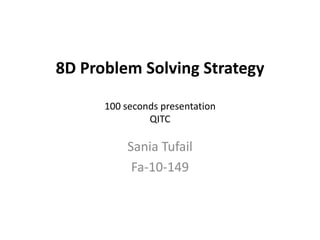
Ford
- 1. 8D Problem Solving Strategy100 seconds presentationQITC Sania Tufail Fa-10-149
- 2. The 8 Disciplines of Problem Solving Structured approach to continuously improve quality popularized by Ford Motor Company as Global 8D Eliminate route cause And prevent their reoccurrences
- 3. D1- Assemble the Team Determine the personnel required for the resolution of the current issue. Generally, a cross-functional team works best, but it’s more important to ensure the correct people are on your team than it is to have a true cross-functional team. Determine your team’s leader.
- 4. D2- Define the Problem Provide as much detail regarding the current issue. Writing an outstanding problem statement is critical to the success of problem solving efforts.
- 5. D3- Implement and Verify Interim Containment Actions (ICAs) Determine the impact of the customer’s issue within your organization. Identify all possible suspect material and segregate that material for further review. List the date codes, lot numbers, etc. that are considered suspect. Determine a method that clearly shows the customer that all product shipped from this date was inspected and known to be acceptable.
- 6. D4- Identify and Verify Root Cause D4 is the important and most difficult step of the 8 disciplines of problem solving. The team investigates the problem and begins to develop theories regarding where and how this issue occurred. Common methods for root cause analysis are: Data Mining,Pareto Charts, Brainstorming Fishbone Diagram (also known as an Ishikawa Diagram or Cause and Effect Diagram) Also in the D4 step, team determines the “escape point,” that is, where in your process did this issue fail to get identified. As the process is followed backwards, it identify the location within your system that the root cause should have been identified but wasn’t. The team must be able to verify that they have indeed identified both the root cause and the escape point, and be able to take action upon the root cause. Returning to the process, the team should be able to make the issue come and go at will, indicating verification of root cause.
- 7. D5- Choose and Verify Permanent Corrective Actions (PCAs) After verifying the root cause, the team assembles to generate potential PCAs. The team will consider topics such as: customer satisfaction, cost, elimination of the root cause, and others when attempting to choose the best PCA from the list of potential PCAs.
- 8. D6- Implement and Validate PCAs Use the selected PCA from D5. Implement this solution. Like in D4, the team should be able to make the problem come and go at will by alternately applying and removing the PCA. Continue to measure the process to ensure effectiveness.
- 9. D7- Prevent Recurrence Sustain the Gains! Regularly follow up on the process measures, again to ensure effectiveness and prevent backsliding. Update all documentation in your Quality Management System. Mistake-proof the process if possible. Identify any potential areas where the same issue could occur and implement the same or similar PCA in those areas.
- 10. D8- Recognize the Efforts of the Team D8 is the most underutilized of the steps in the 8 disciplines of problem solving. While most companies will obtain formal sign-offs for the 8D structure, some fail to commend the team participants for the excellent work they accomplished. It is through this feedback that the team members feel appreciated, making them likely participants for the next issue (when it develops).
- 11. Thanks.
